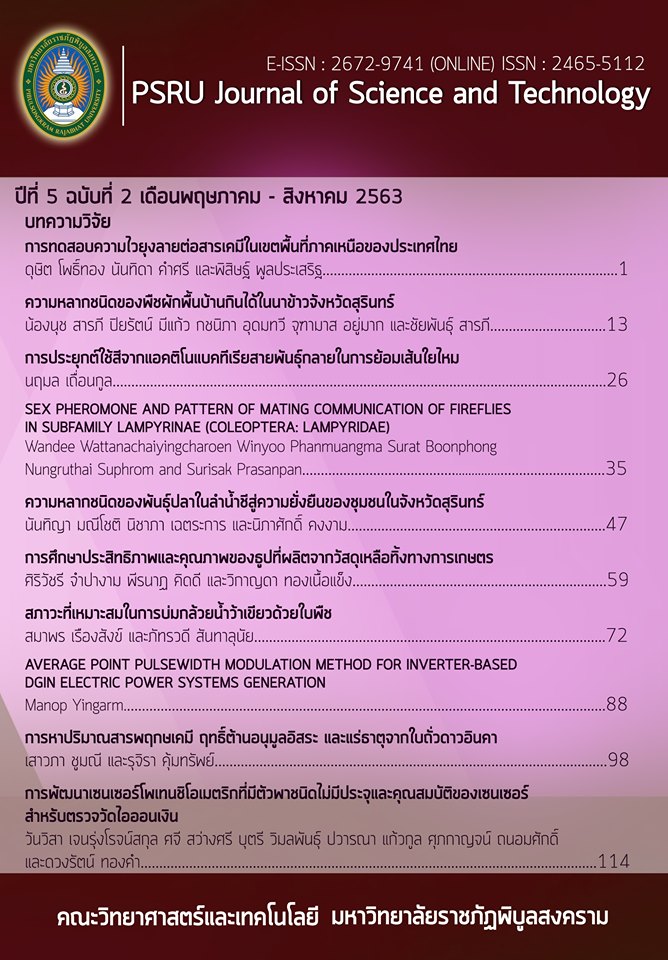APPLICATION OF ACTINOBACTERIA MUTANTS FOR SILK FIBER DYEING
Keywords:
Actinobacteria, Mutant, Dyeing, Silk fiberAbstract
Eight mutant actinobacteria were selected by genetic modification Actinobacteria D7 which induced via ultraviolet (UV) radiation. Each isolated mutant was produced various orange shades on Sodium caseinate agar (SCA) media. This study was aimed to study the production and extraction of dyes using broken-milled rice and silk fibers dyeing color. It was found that the eight mutant actinobacteria were produced violet tones on broken-milled rice. The color pigment which extracted by 70% ethanol provided tones of pink and dye the silk fibers in pink tones. The mutant actinobacteria can be used to produce dye for commercial silk dyeing.
References
จิตภาณี เสาร์บดีรักษ์, น้ำฝน ปัญจนาพงศ์ชัย, และสาโรจน์ ศิริศันสนียกุล. (2557). การกลายพันธุ์ Bacillus subtilis TISTR001 โดยใช้รังสียูวีเพื่อเพิ่มการตรึงไนโตรเจน. ใน การประชุมวิชาการของมหาวิทยาลัยเกษตรศาสตร์ ครั้งที่ 52 (น.1-8). กรุงเทพฯ: มหาวิทยาลัยเกษตรศาสตร์.
ชาลินี คงสวัสดิ์. (2542). การชักนำให้เกิดมิวเตชันในเห็ดหมื่นปี Ganoderma Iucidum (Fr.) Karst. โดยแสงอัลตราไวโอเลต. (วิทยานิพนธ์ปริญญามหาบัณฑิต). จุฬาลงกรณ์มหาวิทยาลัย, สาขาวิชาพันธุศาสตร์.
นฤมล เถื่อนกูล. (2551). การใช้สารสีจากแอคติโนมัยซีตในการย้อมสีเส้นใยไหมและเส้นใยฝ้าย (รายงานการวิจัย). พิษณุโลก: มหาวิทยาลัยราชภัฏพิบูลสงคราม.
นฤมล เถื่อนกูล, และนฤมล หวลระลึก. (2560). การคัดแยกแอคติโนมัยซีตจากดินรังปลวก อำเภอศรีสัชนาลัย จังหวัดสุโขทัย เพื่อใช้ในการย้อมสีเส้นใยไหม. PSRU Journal of Science and Technology, 2(3), 1-8.
วราพร สร้อยมุข, ปาริฉัตร สอนชม, และนฤมล เถื่อนกูล. (2562). การชักนำให้เกิดการเปลี่ยนแปลงสีของStreptomyces D7 และ P2 โดยการใช้รังสีอัลตราไวโอเลต. ใน การประชุมวิชาการระดับชาติพิบูลสงครามวิจัย. ครั้งที่ 5 ประจำปี พ.ศ. 2562 (น. 456-459). พิษณุโลก: มหาวิทยาลัยราชภัฏพิบูลสงคราม.
Aikawa, M., Lopes-Shikida, S.A.R., Lemos, M.F.J.G.C. & Padilla, P.G. (1999). Screening of spontaneous and induced mutants in Streptomyces avermitilis enhances avermectin production. Apply Microbiology and Biotechnology, 52, 558-562.
Baltz, R.H. (2016). Genetic manipulation of secondary metabolite biosynthesis for improved production in Streptomyces and other actinomycetes. Journal of Industrial Microbiology & Biotechnology, 43, 343–370.
Dutta, S., Basak, B., Bhunia, B., Sinha, A. & Dey, A. (2017). Approaches towards the enhanced production of Rapamycin by Streptomyces hygroscopicus MTCC 4003 through mutagenesis and optimization of process parameters by Taguchi orthogonal array methodology. World Journal Microbiology & Biotechnology, 33, 90.
El-Gendy, M.M.A. & EL-Bondkly, A.M.A. (2010). Production and geneticimprovement of a novel antimycotic
agent, Saadamycin, against Dermatophytes and other clinical fungi from Endophytic Streptomyces sp. Hedaya48. Journal of Industrial Microbiology & Biotechnology, 37, 831–841.
Goodfellow, M., Kämpfer, P., Busse, H.J., Trujillo, M.E., Suzuki, K.,Ludwig, W. & Whitman, W.B. (2012). Bergey’s manual of systematic bacteriology, vol 5. The Actinobacteria, part A and B. New York: Springer.
Jimnez, J.T., Sturdkov, M., Brezov, V., Svajdlenka, E. & Novotov, M. (2012). Screening of Mutant Strain Streptomyces mediolani sp. AC37 for (-)-8-O-Methyltetrangomycin Production Enhancement. The Journal of Microbiology, 50(6), 1014–1023.
Kramar, A., Ilic-Tomic, T., Petkovic, M., Radulovic, N., Kostic, M., Jocic, D. & Nikodinovic-Runic, J. (2014). Crude
bacterial extracts of two new Streptomyces sp. isolates as bio-colorants for textile dyeing. World Journal Microbiology Biotechnology, 30, 2231–2240.
Kermeoglu, F., Aksoy, U., Kalender, A., Oztan, M.D., Oguz, E.I. & Kiyan, M. (2018). Determination of the Minimum Inhibitory Concentrations of Alexidine and Chlorhexidine Against Enterococcus faecalis and Candida albicans: An In Vitro Study. CUREUS, 10(2), 1-8.
Krishanti, N.P.R.A., Zulfiana, D., Wikantyoso, B., Zulfitri, A. & Yusuf, S. (2018). Antimicrobial Production by an Actinomycetes Isolated from the Termite Nest. Journal of Tropical Life Science, 8(3), 279–288.
Mo, S., Lee, S.-K., Jin, Yi.-Y., Oh, C.-H. & Suh, J.-W. (2013). Application of a combined approach involving classical random mutagenesis and metabolic engineering to enhance FK506 production in Streptomyces sp. RM7011. Apply Microbiology and Biotechnology, 97, 3053–3062.
Wang, X.-J., Wang, X.-C. & Xiang, W.-S. (2009). Improvement of milbemycin-producing Streptomyces bingchenggensis by rational screening of ultraviolet and chemically induced mutants.World Journal Microbiology & Biotechnology, 25, 1051–1056.
Xueping, L.I., Guojian, Z.H.A.N.G, Tianjiao, Z.H.U., Dehai, L.I. & Qianqun, G.U. (2012). Strain and Culture Medium Optimization for Production Enhancement of Prodiginines from Marine-Derived Streptomyces sp. GQQ-10. Journal of Ocean University of China (Oceanic and Coastal Sea Research), 11(3), 361-365.
Zvenigorodskii, V.I., Tyaglov, B.V. & Voeikova, T.A. (2001). Isolation ofcomponents of the peptide antibiotic virginiamycin and breeding of their producer, Streptomyces virginiae. Applied Biochemistry and Microbiology, 37(3), 260-266.
Downloads
Published
How to Cite
Issue
Section
License
กองบรรณาธิการขอสงวนสิทธิ์ในการปรับปรุงแก้ไขตัวอักษรและคำสะกดต่างๆ ที่ไม่ถูกต้อง และต้นฉบับที่ได้รับการตีพิมพ์ในวารสาร PSRU Journal of Science and Technology ถือเป็นกรรมสิทธิ์ของคณะวิทยาศาสตร์และเทคโนโลยี มหาวิทยาลัยราชภัฏพิบูลสงคราม และ
ผลการพิจารณาคัดเลือกบทความตีพิมพ์ในวารสารให้ถือมติของกองบรรณาธิการเป็นที่สิ้นสุด







